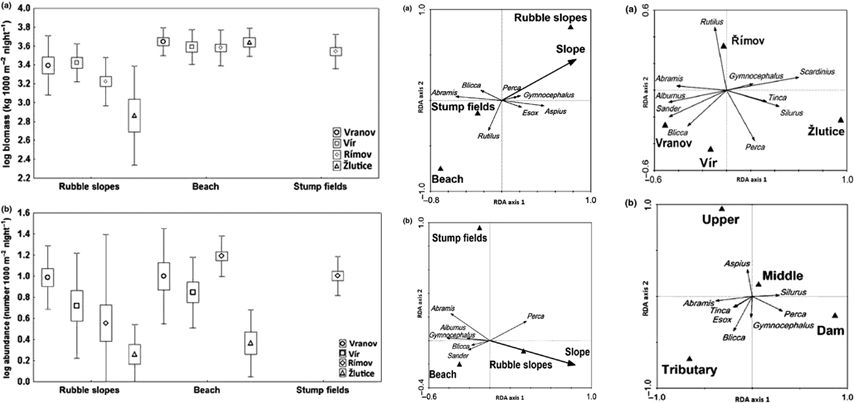Fish associations with different types of littoral habitats were studied in four canyon-shaped reservoirs in the Czech Republic in years 2010 and 2011 by gillnets. Two to three habitats per reservoir–beaches (former meadows), stump fields (former forest) and rubble slopes–were defined and sampled along the longitudinal axis of reservoirs. Effects of reservoir, habitat and locality (position along longitudinal axis) on fish biomass, abundance and species structure were tested for juvenile and adult fish separately. Hierarchical analysis of variance revealed that habitats differed significantly in fish biomass and abundance. Redundancy analysis showed that analysed environmental variables had significant influence on fish community structure. Most variability in community structure was explained by reservoir and then by combination of habitat and slope steepness. Locality position had the smallest influence on community structure. For both adult and juvenile fish total abundance and biomass, the most inhabited habitat was beaches; rubble slopes were the least inhabited. Habitat associations differed among species. Among adults, bream Abramis brama, white bream Blicca bjoerkna and roach Rutilus rutilus were associated with beaches and stump fields, whereas perch Perca fluviatilis, ruffe Gymnocephalus cernuus, asp Aspius aspius and pike Esox lucius were associated with rubble slopes. Bream, white bream, bleak Alburnus alburnus, roach, ruffe and pikeperch Sander lucioperca were associated with beaches among juveniles, whereas the only juvenile associated with rubble slopes was perch. We showed that most common species are associated with distinct habitats and also that utilisation of various littoral habitats differs in general.
Keywords: Abramis brama; Alburnus alburnus; asp; Aspius aspius; bleak; Blicca bjoerkna; bream; community structure; Esox lucius; gillnet; Gymnocephalus cernuus; habitat associations; Perca fluviatilis; perch; pike; pikeperch; reservoir; roach; ruffe; Rutilus rutilus; Sander lucioperca; slope steepness; structural complexity; white bream

